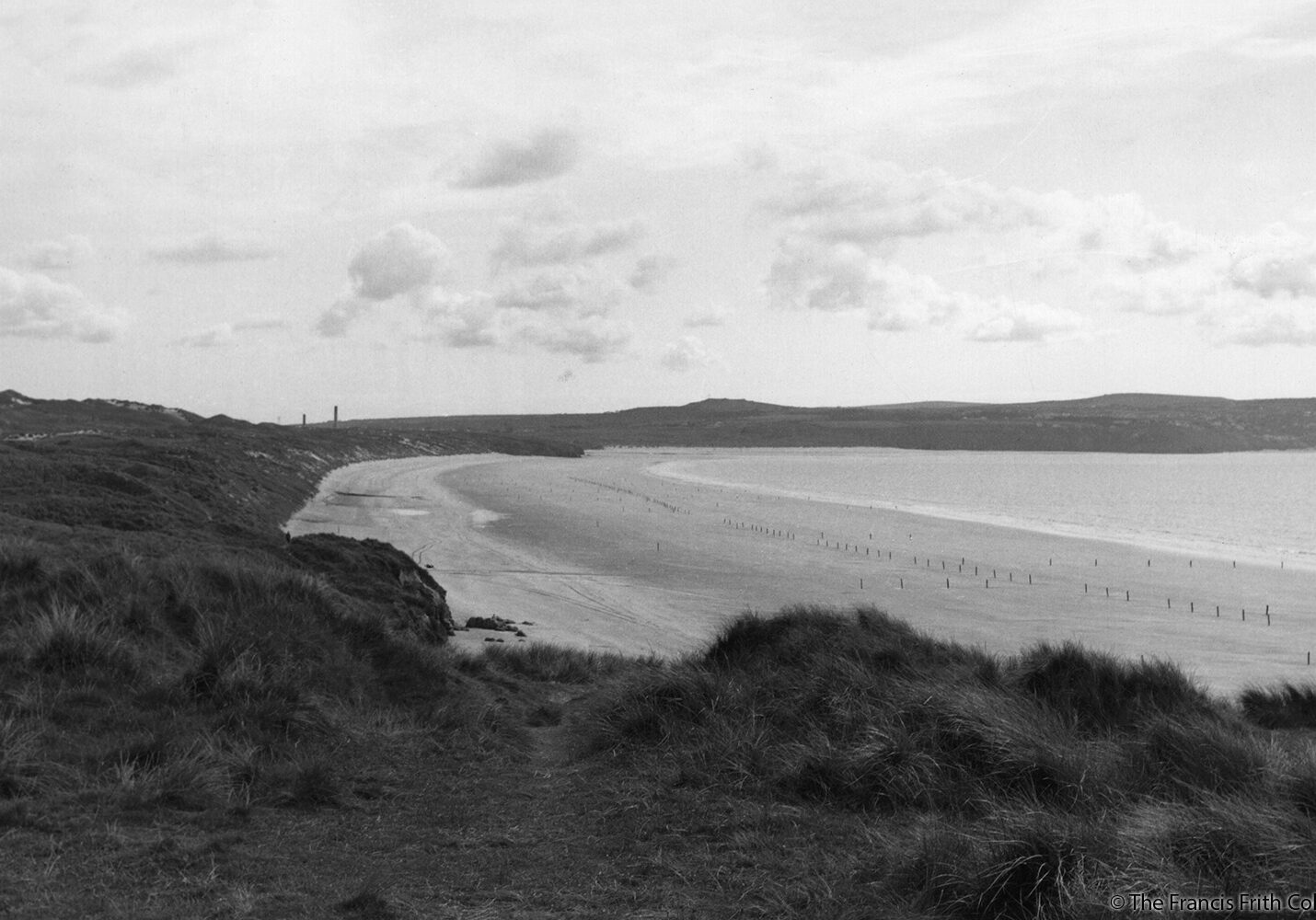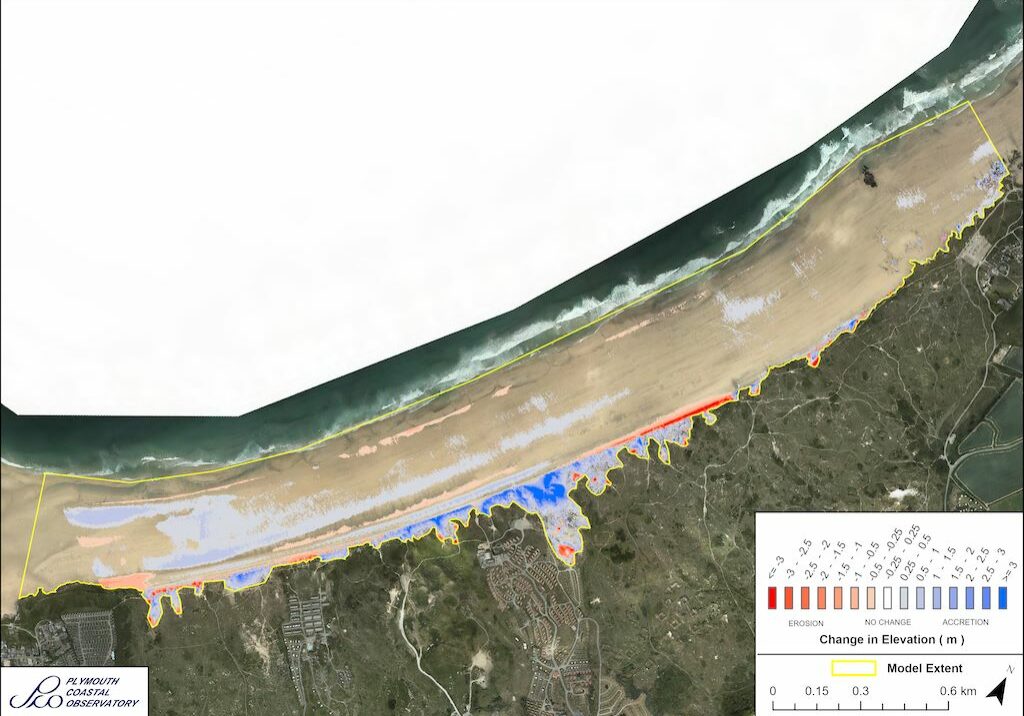
Mexico Towans and Upton Towans (Cornish: Tewyn, meaning ‘sand dune’) are a part of the wider Towans associated with St Ives Bay. The series of individually named Towans indicate that the sands associated with the location have long been part of the sites rich heritage. This can be appreciated when looking at the expanse of sand to both the east and west of the location.
Both Upton and Mexico Towans are north-west facing sites, and a small portion of an extensive beach that stretches for almost 7 kilometres from Carrack Gladden to the west and Godrevy Point to the north. As the tide drops from high water, all the ‘Towans’ join up to provide an impressive stretch of sand. The sediments associated with the gently sloping shoreline of Mexico and Upton Towans are soft, medium grained with a high shell content. The uppershore of the beach is dominated by the high climbing extensive dunes, which are designated for a diversity of ecological reasons.
The locations are considered as more of a rural beach environment, but their proximity to the town of Hayle and holiday parks within the wider Towans, means they can become seasonally quite busy.


Coastal Change
The coastline of Cornwall is an ever-changing environment. It is energetic, dynamic, never still and changes with each wave and each tidal cycle. Some of the changes we see are gradual and barely noticeable, whilst others, such as rockfalls, happen suddenly and often shockingly.
From one visit to the next it can sometimes be difficult to see how a beach and dune system has changed, but information has been collected, and is being collected through the Making Space for Sand project, to help us better understand how the coastline is changing. The purpose of this section of the website is to understand each location has changed over time, how it could change in the future and understand the policies that influence how we can respond to these changes.
Shoreline Management Plans (SMP)
The Shoreline Management Plan (SMP) is a strategic planning and management assessment tool that helps identify and measure the risk associated coastal erosion and coastal flooding. The document makes a number of policy recommendations over short, medium and long term timeframes setting out a strategic approach to managing the built, natural and historic environments associated with the coastline. Within SMP there are four policy approaches which have been assigned to stretches of coastlines. The four policies are: No Active Intervention (NAI), Hold the Line (HTL), Managed realignment (MR), and Advance the line (ATL).
Mexico and Upton Towans sit within Policy Development Zone 10 (PDZ10), in Management Area 28 (MA28), within Policy Unit (PU) 28.2. The policy recommendations for this policy unit are detailed in the table below and the SMP can be accessed through the Cornwall Council website.
Use your touchscreen
to scroll the below table
| Policy Unit | SMP2 Policy Plan | ||||
| 2025 | 2055 | 2105 | Rationale | ||
| 28.1 | Black Cliff
Main Policy Sub Policy
|
NAI DnD |
NAI DnD |
NAI DnD |
Erosion and flood risk mapping indicates very low risk (and no assets at risk) so no intervention required. NAI is the preferred approach. Allow natural coastal evolution to support conservation and local designations.
|
| 28.2 | Mexico Towans to Gwithian Towans
Main Policy Sub Policy
|
MR NF |
MR NF |
MR NF |
A managed realignment approach is preferred to accommodate the natural variability of this area. This would allow priority to be given to enhancement of the natural dune system as a UK priority BAP
Habitat. MR policy preferred to accommodate the natural variability of the area and enhance the natural dune system as a UK priority BAP Habitat. The area is under pressure from existing development and infrastructure of the holiday park behind the dunes. Number of blow outs along the frontage associated with access points to the holiday parks. Loss of dune frontage expected in response to sea level rise, but it expected that there are sufficient sediment sources present to prevent significant dune roll back in the short to medium term.
|
| Key Main Policy: HTL - Hold the Line, A - Advance the Line, NAI – No Active Intervention MR – Managed Realignment
Sub Policy: DnD – Do not Defend, NF – Natural Features |
|||||


National Coastal Erosion Risk Mapping (NCERM) provides a baseline of coastal erosion, for the coastline of England, over short, medium and long-term timeframes. The data is based on the natural and defence characteristics of the coastline and provides rates of erosion at differing levels of confidence to help better plan for worse case scenarios. The data provided is for guidance and does not estimate the absolute location of the future coastline.
The basic NCERM lines show erosion estimates for the Short Term (ST-20 years), Medium Term (MT-50 years) and Long Term (LT- 100 years). The data is further categorised by probability: 05 is 5% probability (a 1 in 20 chance of being exceeded) Red Shading, 50 is 50% probability of being exceeded (a 1 in 2 chance of being either exceeded or not exceeded) Orange Shading and 95 is 95% probability (a 19 in 20 chance of being exceeded) Yellow Shading. Click the link below to access the Cornwall Council NCERM Mapping site read the about section then click on layers.

Historical Images of the Towans
Historical photographs provide a powerful insight into how the Cornish coastline has changed within the past Century. The Making Space for Sand project are working in collaboration with the Francis Frith collection and have been given permission to share historical images on a number of beaches considered within the project.
In looking back, we can better understand how the coastline has changed, helping us understand not only how the coastal fringe has developed but also the potential future changes that we my observe. When this is considered alongside forecasts of coastal erosion and sea level rise it will help enable us to better adapt to our changing coastline.


Modelling Coastal Change
Using data that has already been collected, combined with data collected through the Making Space for Sand project, a series of models will be carried out at each location. This will help us better understand how each location may respond to sea level rise and gain a deeper understanding of how coastal sediments move and behave.
The complexity of the modelling, and the data collection that helps inform it, means that modelling outputs will not be the same on all sites. Some locations will be more thoroughly investigated to understand more complex issues and provide data that can be more widely applied to other sites with similar characteristics.
As the project develops this section of the website will expand, sharing new reports and coastal change projections when they are produced.
LiDAR surveys, which are explained on the Data Modelling page, have been carried out by the South West Coastal Monitoring program at this location. The image shared here visualises where sand has eroded (areas shaded in red) and where it has built up (areas shaded in blue), between the LiDAR surveys carried out in 2003 and 2020. The darker the shade of red or blue the greater the amount of sand erosion or accumulation has been observed. The image helps visualise that beaches are areas that change shape over time and will continue to do so as sea levels rise.




Beach and Dune Ecology
Beaches and dunes represent an important transition between the marine environment and the terrestrial environment. This transition creates a range of special habitats and exposes a range of interesting features, which that can result in these spaces being highly designated and protected. The Making Space for Sand project will survey a number of dune systems. These surveys will help highlight how they may be changing, will identify rare species, will map invasive species, help us understand overall dune condition and identify potential constraints to improving their condition.
There are a range of designations that recognise a variety of different features. There are also a number of dunes systems where data has been collected to understand their habitat value. These are explored, on a site-by-site basis, in the section below.

Designations
Site of Special Scientific Interest (SSSI)
A Site of Special Scientific Interest or SSSI is a statutory conservation designation notified by Natural England denoting protection for biological and/or geological characteristics. The natural wildlife and geological features of SSSI’s are considered to be irreplaceable parts of the national heritage. These are protected in order to preserve their importance, and to prevent damage and development.
Image of the view across the Towans
Gwithian to Mexico Towans SSSI
The Gwithian to Mexico Towans SSSI covers and area of 371.1 hectares. Gwithian to Mexico Towans constitutes the second largest dune system in Cornwall, stretching for approximately 3km. This exposed, dynamic dune system is subject to the full force of Atlantic gales, resulting in several large blow-outs along the seaward margin. This complex and extensive dune system supports a rich and diverse flora.

Beach Dune Management Plan
Many of the sand dunes and beaches around Cornwall’s coast are experiencing net erosion and sediment loss. This is due, in part, to lack of new sediment input to the shoreline system and rising sea levels. This is a pressing concern as these environments provide protection against the risk of coastal flooding, provide important habitats that cannot be easily recreated elsewhere if lost and help support the regions thriving tourism industry. It is therefore vital that the sand dunes and beaches around Cornwall’s coast are managed in a more sustainable way that balances the combined functions of beach-dune system.
The Making Space for Sand project hope to develop a number of Beach Dune Management Plans, to complement those that have already been developed by Cornwall Council. It is anticipated that a BDMP will be developed for this location. The aim of the BDMP’s will be to:
- Identify the best day-to-day management approach in terms of monitoring and intervention for the beach and dune system.
- Provide a longer-term approach to beach and dune management based upon an up-to-date understanding of habitat condition, coastal processes at the site, as well as predictions of future coastal evolution.
If you are interested in providing information and data or want to share you knowledge of changes observed on a site where a beach dune management plan is being considered please make contact with the Making Space for Sand project using the email provided at the bottom of this page or on the Community Engagement page.
Sign up to Making Space for Sand
If you would like to get involved in helping to make dunes more resilient and biodiverse, want to help develop coastal adaptation and emergency plans or just want to know more about what the project is learning about coastal change, please click here:


